Part 2 of 5
The first task of repotting is removing the tree from the pot. The next step is preparing the pot into which the bonsai will be planted. This year I’m repotting the maple back into the same pot. I usually go out of my way to make a change when I repot, but this pot will do well for the upcoming exhibit. I’ll be sure to make a change next time.
It’s best to prepare the pot before working on the roots to prevent them from drying out. It involves scrubbing, covering the drainage holes with screen, and wiring the pot. It begins with a brush.

Grimy pot
I like to use a natural-bristle brush, but plastic brushes work well too. What’s important is the extent to which you clean. I cannot overstate the importance of this next bit: do not be over zealous in your scrubbing! I’ve heard many stories of people new to bonsai removing all of the “grime” from old pots only to learn they’ve removed the patina that gave the pot its character and its value.
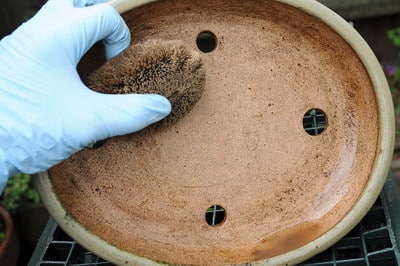
Scrubbing away soil residue
How much to scrub? A good way to start is to scrub very lightly. This will remove most of the crust or loose dirt that can cling to pots. Beyond that proceed with care. Some white residue from hard water is acceptable, too much is not. Green colored build-up is rarely appropriate. If you ever have a question about a specific pot, don’t hesitate to take it to someone you trust for advice. It’s not worth the risk and it could save you some effort.
Once the pot is relatively clean it’s time to cover the drainage holes. Good bonsai screen comes in large rolls and is flat on one side. Placing the flat side up or down may reveal your teacher’s preference, but I don’t know that it will make a big difference. I place the flat side down, and do so for a reason, but one has to draw the line of how much detail to provide somewhere and I’m drawing it here.
Likewise clips. One can choose among u-clips, z-clips and other clips I don’t know by name. Each has its good and bad points. I tend to stick with z-clips for mid-sized drainage holes.
The process is simple once you know how to do it. Measure a piece of wire about four times the diameter of the drainage hole. Bend the wire into a “z” shape with your hands and finish the bends with a pliers. From there, bend down the ends so they just fit inside the drainage holes. A good fit will prevent the screen from moving around. This helps keep soil in and bugs out.
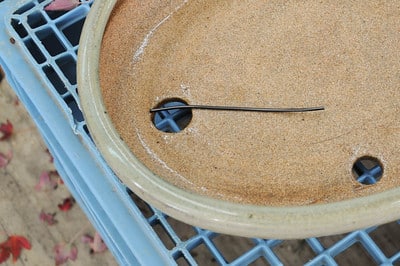
Measuring wire for the clip
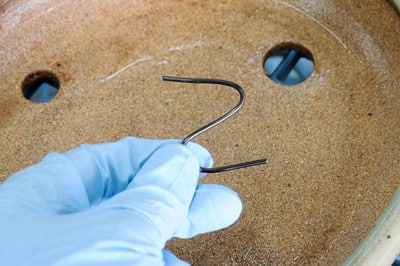
Starting a clip
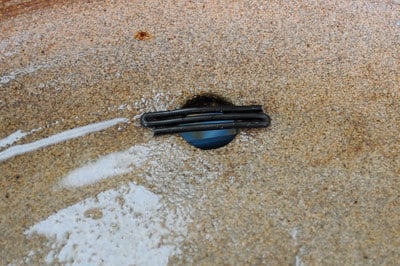
Checking the size of the clip
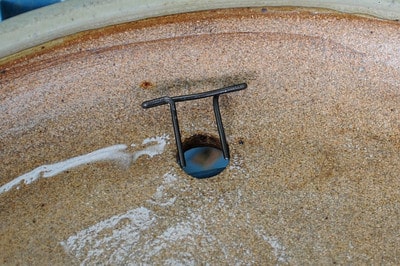
A completed “clip”
After the clips are in place I measure the tie-down wire. For rectangular and oval-shaped pots, start with two long sides and one short side as a guide. Differing shapes and drainage hole arrangements necessitate adjustments that get easier to make with experience.
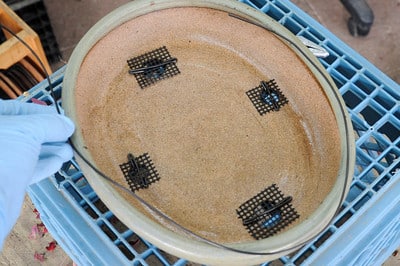
Measuring the tie-down wire
There are a number of techniques for securing trees in bonsai pots. Each method entails a certain arrangement of the tie-down wires. For the method I’ll be using, I arrange the wires as follows:
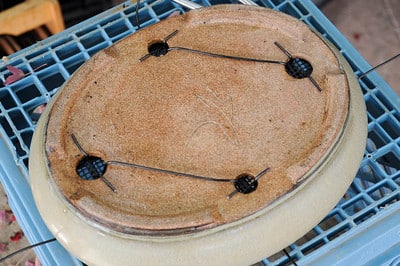
From below
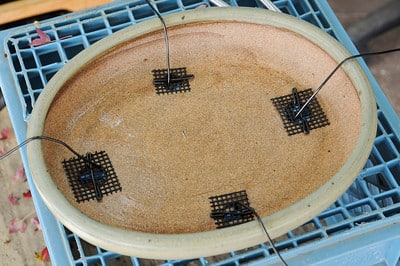
From above
Once the wires are in place, I bend them out of the way and set the pot aside until I’m ready to set the tree.
Why bother with wires at all? It’s a reflection of the difference between a nursery trees and bonsai. Bonsai typically require more care. Holding the roots in place while they grow into their new environment minimizes the damage that can result from jostling a tree around. It keeps expensive trees from blowing out of their pots and tippy trees from falling over. It’s a sign that we really care about the well-being of our trees.
On another note, one may have noticed that I wired the pot with aluminum rather than copper wire. It’s cheaper.
Next up: Part 3 – Root work.
Subscribe to Bonsai Tonight
New Posts Delivered Every Tuesday and Friday
Alex V says
“one has to draw the line of how much detail to provide somewhere and I’m drawing it here” You bonsai professionals are always keeping secrets on us!! It was fun seeing everyone last weekend, I look forward to seeing how the blog post goes, great job so far.
xwires says
Thanks – I’m glad you could make it. I’ll have to devote more posts to “screen theory,” “moss theory,” and other bonsai related ephemera & marginalia. Either that or write a book on the topic.
For those curious about screen sidedness: when you place the flat side up the edges of the screen can stick up. Better to avoid that.
John Kirby says
And I thought you were just sleeping over there in he corner, well, until you brought up Alice B. Toklas. Great bit on repotting.